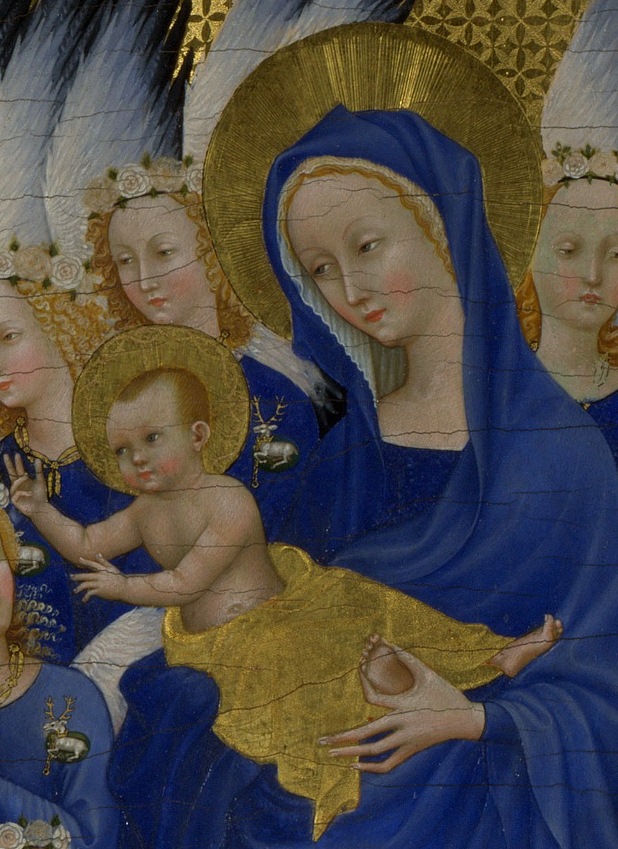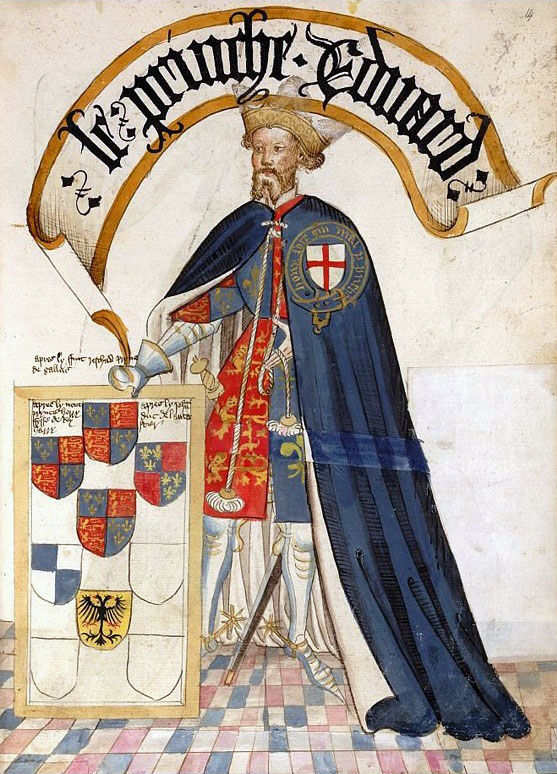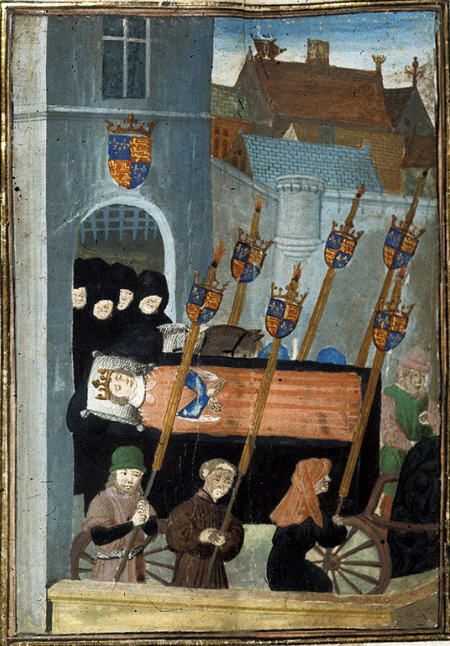by Susan Flantzer © Unofficial Royalty 2016

Credit – Wikipedia
King Richard II of England was born in the Archbishop’s Palace in Bordeaux, then in the English-held Duchy of Aquitaine (now in France) on January 6, 1367. Because of his birthplace, he was known as Richard of Bordeaux. Richard was the second son and second child of Edward, Prince of Wales (known as the Black Prince), eldest son and heir of King Edward III of England, and Joan of Kent, 4th Countess of Kent in her own right. Joan was a grandchild of King Edward I of England. Her father was Edmund of Woodstock, 1st Earl of Kent, a son of Edward I’s second marriage. Richard had one elder sibling, Edward of Angoulême (1365 – 1370), who died young of the plague. After his elder brother’s death, Richard became the second in the line of succession to the throne after his father.

Edward of Angoulême and his mother Joan of Kent, depicted on the Wilton Diptych; Credit – Wikipedia
Richard had five half-siblings from his mother’s first marriage to Thomas Holland, 1st Earl of Kent, 2nd Baron Holland
- Thomas Holland, 2nd Earl of Kent (1350 – 1397), married Lady Alice FitzAlan; had issue
- John Holland, 1st Duke of Exeter (circa 1352 – 1400), married Elizabeth of Lancaster, a daughter of John of Gaunt; had issue
- Edmund Holland (c. 1354), died young
- Lady Joan Holland (1356–1384), married John IV, Duke of Brittany; no issue
- Lady Maud Holland (1359–1391), married (1) Hugh Courtenay, no issue; (2) Waleran III of Luxembourg, Count of Ligny, had issue
Edward, Prince of Wales (the Black Prince), Richard’s father, was King Edward III’s representative in Aquitaine, and the king had created Edward and his wife Joan Prince and Princess of Aquitaine. Richard had been born in Aquitaine, but his family returned to England in 1371, shortly after his brother’s death. When in England, the chief residences of Edward’s family were at Wallingford Castle in Berkshire (since 1974 in Oxfordshire), and at Berkhamsted Castle in Hertfordshire. The Black Prince was an exceptional military leader, and his victories over the French at the Battle of Crécy and the Battle of Poitiers made him very popular during his lifetime. In 1348, he became the first Knight of the Garter and was one of the order’s 25 founders.

Edward, Prince of Wales as Knight of the Order of the Garter, illustration from the Bruges Garter Book; Credit – Wikipedia
Richard’s father entrusted his son’s education to his boyhood friend Sir Simon de Burley, who instilled in Richard a love of literature and music as well as a sense of the importance of his royal office. Richard was the first English monarch who was fluent in English as well as the traditional Norman French of his ancestors. While in the midst of his childhood, nine-year-old Richard’s life changed when his father died at the age of 45 on June 8, 1376. Richard was now the heir to his grandfather’s throne. Because it was feared that Richard’s uncle John of Gaunt might usurp his place in the succession, Richard was quickly given his father’s titles: Prince of Wales, Duke of Cornwall, and Earl of Chester. On June 21, 1377, King Edward III died and his ten-year-old grandson was then King Richard II.

King Richard II of England with his court after his coronation; Credit – Wikipedia
Richard’s coronation took place on July 16, 1377, at Westminster Abbey, just eleven days after his grandfather’s funeral. The quickness with which all this happened was certainly affected by the controversial succession of a child king whose father had not been the king. Some believed that one of King Edward III’s younger sons (there were three still alive: John of Gaunt, Duke of Lancaster; Edmund of Langley, Duke of York; and Thomas of Woodstock, Duke of Gloucester) should be king. Parliament, which was in a dispute with John of Gaunt at that time, supported Richard’s accession to the throne. John of Gaunt and his two brothers were excluded from councils that ruled during Richard’s minority, but as the uncles of the king, they still held great informal influence over the business of government. By 1380, the councils were abolished because Parliament distrusted Richard’s friends and councilors, particularly his tutor Sir Simon de Burley and Robert de Vere, Duke of Ireland, Marquess of Dublin, and 9th Earl of Oxford. The uncertainty in the matter of Richard II’s succession laid the groundwork for the Wars of the Roses when the House of York and the House of Lancaster battled for the English throne.

Richard’s uncle John of Gaunt; Credit – Wikipedia
In 1381, the Peasants’ Revolt led by Wat Tyler occurred over a poll tax of a shilling on all people over the age of 15. The revolt had started in Kent and Essex but ultimately came to London where John of Gaunt’s Savoy Palace was burned down and the Archbishop of Canterbury Simon Sudbury, who was also Lord Chancellor, and the Lord High Treasurer Robert Hales were both killed by the rebels. 14-year-old Richard rode out to Mile End in London to meet the rebels. Addressing the rebels in English, Richard agreed to their demands. This did not pacify the rebels and they continued the burning, looting, and killing. The next day, Richard met the rebel leader Wat Tyler at Smithfield in London and again agreed to meet their demands. However, the rebels were not convinced, the king’s men grew uneasy, and an altercation occurred in which Wat Tyler was pulled off his horse and killed. Richard, acting calmly, led the rebel mob away from the scene, granted clemency, and allowed the rebels to disperse and return to their homes. When disturbances occurred in other parts of England, Richard revoked his agreement and the clemency and went to Essex to personally defeat the last rebels. At a young age, Richard did show courage and determination in ending the rebellion. However, he saw the danger of his subjects’ disobedience which threatened his authority and this helped shape his ideas of absolute monarchy which would later prove literally fatal.

Richard II watches Wat Tyler’s death and addresses the peasants in the background: taken from the Gruuthuse manuscript of Froissart’s Chroniques (c. 1475); Credit – Wikipedia
When Richard was 15, a bride was sought for him, and Anne of Bohemia, the eldest child of Charles IV, Holy Roman Emperor and King of Bohemia, and his fourth wife, Elizabeth of Pomerania, seemed a logical choice as Bohemia and the Holy Roman Empire were seen as potential allies against France in the ongoing Hundred Years’ War. However, the potential marriage was unpopular with the nobility and members of Parliament because Anne brought no dowry. Richard’s tutor and his father’s close friend Sir Simon de Burley was sent to negotiate the marriage contract and then escort the 15-year-old bride-to-be to England. After Anne arrived in Dover, England, a huge wave wrecked the ship in which she had sailed, and this was seen as a bad omen. The young couple was married at Westminster Abbey in London on January 22, 1382, the fifth royal wedding at the Abbey. It was not until the wedding of Princess Patricia of Connaught, a granddaughter of Queen Victoria, and Alexander Ramsay in 1919, 537 years later, that another royal wedding was held at Westminster Abbey. Richard and Anne had no children.

Anne of Bohemia with her husband King Richard II of England; Credit: Wikipedia
Since 1337, England had been fighting France in the Hundred Years’ War, and the English had been consistently losing territory to the French since 1369. Richard wanted to negotiate peace with France, but much of the nobility wanted to continue the war. In 1386, Parliament blamed Richard’s advisers for the military failures and accused them of misusing funds intended for the war. Parliament authorized a commission of nobles known as the Lords Appellant to take over the management of the kingdom and act as Richard’s regents. There were originally three Lords Appellant: Thomas of Woodstock, Duke of Gloucester, son of Edward III and Richard’s uncle; Richard FitzAlan, 11th Earl of Arundel; and Thomas de Beauchamp, 12th Earl of Warwick. Later, Henry Bolingbroke, Earl of Derby (son of John of Gaunt, Richard’s first cousin and the future King Henry IV), and Thomas de Mowbray, 1st Duke of Norfolk also became Lords Appellant. Richard did not recognize the authority of the Lords Appellant and started an unsuccessful military attempt to overthrow the Lords Appellant and negotiate peace with France. In 1387, the Lords Appellant launched an armed rebellion against King Richard and defeated an army under Robert de Vere, Earl of Oxford at the Battle of Radcot Bridge, outside Oxford. They maintained Richard as a figurehead with little real power. Parliament convicted almost all of Richard’s advisers of treason. Most of Richard’s advisers were executed and a few were exiled.

Depiction of Mowbray, Arundel, Gloucester, Derby and Warwick demanding of Richard II that he let them prove by arms the justice of their rebellion; Credit – Wikipedia
Richard’s uncle John of Gaunt had left England in 1386 to seek the throne of Castile, claimed by the right of his second wife, Constance of Castile, whom he had married in 1371. Because of the crisis in England, in 1389, Richard’s uncle and now his supporter, John of Gaunt, returned from Castile and Richard was able to rebuild his power gradually until 1397, when he reasserted his authority and destroyed the principal three among the Lords Appellant.
Richard never forgave the Lords Appellant. His uncle Thomas, Duke Gloucester was murdered in captivity in Calais, probably on Richard’s orders. Richard FitzAlan, Earl of Arundel was beheaded. Thomas de Beauchamp, Earl of Warwick lost his title and his lands and was imprisoned on the Isle of Man until Richard was overthrown by Henry Bolingbroke. Henry Bolingbroke, Earl of Derby and Thomas de Mowbray, Duke of Norfolk were both exiled in 1399 and Richard revoked the permission he had given them to sue for any inheritance which fell due, as it did in relation to Mowbray’s grandmother and, more significantly, of Bolingbroke’s father, John of Gaunt. The actions Richard took against his first cousin would ultimately result in his downfall.
In June of 1394, Queen Anne became ill with the plague while at Sheen Palace with her husband. She died three days later on June 7, 1394, at the age of 28. King Richard II was so devastated by Anne’s death that he ordered Sheen Palace to be destroyed. For almost 20 years it lay in ruins until King Henry V started a rebuilding project in 1414. With Richard being childless, the heir presumptive to the throne was Roger Mortimer, 4th Earl of March who was the grandson of Richard’s deceased uncle Lionel of Antwerp, Duke of Clarence. Lionel of Antwerp was the second son of King Edward III so his heirs had a superior genealogical claim to the throne over that of Edward III’s third son John of Gaunt. Despite the fact that Richard officially recognized the claim of Roger Mortimer, the claim was unlikely to remain uncontested.
Soon after the death of Anne of Bohemia in 1394, the childless King Richard II began a search for a new wife. He turned to France seeking an alliance, and after negotiations, a marriage was arranged between Isabella of Valois and Richard who was 22 years older than his bride. Isabella was the daughter of King Charles VI of France and Isabeau of Bavaria. This marriage had many opponents, especially Louis I, Duke of Orléans, younger brother of the French king and Thomas of Woodstock, Duke of Gloucester, youngest uncle of the English king. Nevertheless, on November 1, 1396, at the Church of St. Nicholas in Calais, seven-year-old Isabella married 29-year-old Richard. Richard and Isabella left for England a few days later and on November 23, 1396, she made her state entry into London. The couple had no children due to Isabella’s young age. After Richard’s death, Isabella returned to France and married her cousin Charles of Orléans. At the age of 19, she died on September 14, 1409, in Blois, France a few hours after giving birth to her only child.

Richard and Isabella on their wedding day; Credit – Wikipedia
In 1398, Henry Bolingbroke, first cousin of King Richard II and the eldest child of King Edward III’s third son John of Gaunt, quarreled with Thomas de Mowbray, 1st Duke of Norfolk, who accused him of treason. The two men planned to duel, but instead, King Richard II banished them from England, and Henry went to France. John of Gaunt died on February 3, 1399, and Richard confiscated the estates of his uncle and stipulated that Henry would have to ask him to restore the estates. Henry returned to England while his cousin Richard was on a military campaign in Ireland and began a military campaign of his own, confiscating the land of those who had opposed him. King Richard II eventually was abandoned by his supporters and was forced by Parliament on September 29, 1399, to abdicate the crown to his cousin Henry. King Henry IV, the first king of the House of Lancaster, was crowned in Westminster Abbey on October 13, 1399. Richard was imprisoned at Pontefract Castle in Yorkshire where he died on or around February 14, 1400. The exact cause of his death, thought to have been starvation, is unknown.

Richard being taken into custody by Henry Percy, 1st Earl of Northumberland (Froissart); Credit – Wikipedia
Richard’s body was taken south from Pontefract Castle and displayed in Old St Paul’s Cathedral in London on February 17, 1400, before burial in Kings Langley Church on March 6, 1400.

King Richard II’s funeral; Credit – Wikipedia
In 1413, King Henry V of England, son of King Henry IV, to atone for his father’s act of murder and to silence the rumors of Richard’s survival, had Richard’s remains moved to Westminster Abbey where they were placed in an elaborate tomb Richard had constructed for his first wife Anne of Bohemia.

Tomb of King Richard II of England and Anne of Bohemia in Westminster Abbey; Photo Credit – http://www.westminster-abbey.org
This article is the intellectual property of Unofficial Royalty and is NOT TO BE COPIED, EDITED, OR POSTED IN ANY FORM ON ANOTHER WEBSITE under any circumstances. It is permissible to use a link that directs to Unofficial Royalty.
England: House of Plantagenet Resources at Unofficial Royalty
- United Kingdom of Great Britain and Northern Ireland Index
- House of Plantagenet Index (1216 – 1399)
- British Royal Births, Marriages, Deaths, and Other Important Events
- Coronations after the Norman Conquest (1066 – present)
- History and Traditions: Norman and Plantagenet Weddings
- House of Plantagenet Burial Sites
